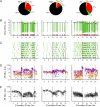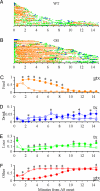A robust automated system elucidates mouse home cage behavioral structure
- PMID: 19106295
- PMCID: PMC2634928
- DOI: 10.1073/pnas.0809053106
A robust automated system elucidates mouse home cage behavioral structure
Abstract
Patterns of behavior exhibited by mice in their home cages reflect the function and interaction of numerous behavioral and physiological systems. Detailed assessment of these patterns thus has the potential to provide a powerful tool for understanding basic aspects of behavioral regulation and their perturbation by disease processes. However, the capacity to identify and examine these patterns in terms of their discrete levels of organization across diverse behaviors has been difficult to achieve and automate. Here, we describe an automated approach for the quantitative characterization of fundamental behavioral elements and their patterns in the freely behaving mouse. We demonstrate the utility of this approach by identifying unique features of home cage behavioral structure and changes in distinct levels of behavioral organization in mice with single gene mutations altering energy balance. The robust, automated, reproducible quantification of mouse home cage behavioral structure detailed here should have wide applicability for the study of mammalian physiology, behavior, and disease.
Conflict of interest statement
The authors declare no conflict of interest.
Figures







Comment in
-
Simultaneous behavioral characterizations: Embracing complexity.Proc Natl Acad Sci U S A. 2008 Dec 30;105(52):20563-4. doi: 10.1073/pnas.0811546106. Epub 2008 Dec 23. Proc Natl Acad Sci U S A. 2008. PMID: 19106290 Free PMC article. No abstract available.
References
-
- de Visser L, van den Bos R, Kuurman WW, Kas MJ, Spruijt BM. Novel approach to the behavioural characterization of inbred mice: Automated home cage observations. Genes Brain Behav. 2006;5:458–466. - PubMed
-
- Tecott LH, Nestler EJ. Neurobehavioral assessment in the information age. Nat Neurosci. 2004;7:462–466. - PubMed
-
- McFarland DJ. Decision making in animals. Nature. 1977;269:15–21.
-
- Oatley K. Brain mechanisms and motivation. Nature. 1970;225:797–801. - PubMed
-
- Prescott TJ, Redgrave P, Gurney K. Layered control architectures in robots and vertebrates. Adaptive Behav. 1999;7:99–127.
Publication types
MeSH terms
Grants and funding
- MH077128/MH/NIMH NIH HHS/United States
- AG026043/AG/NIA NIH HHS/United States
- R01 MH077128/MH/NIMH NIH HHS/United States
- MH1949/MH/NIMH NIH HHS/United States
- HHMI/Howard Hughes Medical Institute/United States
- K08 MH071671/MH/NIMH NIH HHS/United States
- K02 MH001949/MH/NIMH NIH HHS/United States
- MH079145/MH/NIMH NIH HHS/United States
- R21 AG026043/AG/NIA NIH HHS/United States
- MH71671/MH/NIMH NIH HHS/United States
- R01 MH061624/MH/NIMH NIH HHS/United States
- MH61624/MH/NIMH NIH HHS/United States
- R21 MH079145/MH/NIMH NIH HHS/United States
LinkOut - more resources
Full Text Sources
Other Literature Sources

